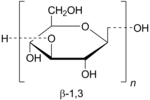Curdlan
 | |
| Identifiers | |
|---|---|
| 54724-00-4 | |
| E number | E424 (thickeners, ...) |
| Properties | |
| (C6H10O5)n | |
| Appearance | odourless white powder |
| Except where otherwise noted, data are given for materials in their standard state (at 25 °C [77 °F], 100 kPa). | |
| | |
| Infobox references | |
Curdlan is a linear beta-1,3-glucan, a high-molecular-weight polymer of glucose. Curdlan consists of β-(1,3)-linked glucose residues and forms elastic gels upon heating in aqueous suspension. It is produced by non-pathogenic bacteria such as Agrobacterium biobar. The production of curdlan by Alcaligenes faecalis is being developed to be used in gel production as well.
Extracellular and capsular polysaccharides are produced by a variety of pathogenic and soil-dwelling bacteria. Curdlan is a neutral β-(1,3)-glucan, perhaps with a few intra- or interchain 1,6-linkages, produced as an exopolysaccharide by soil bacteria of the family Rhizobiaceae.[1] Four genes required for curdlan production have been identified in Agrobacterium sp. ATCC31749, which produces curdlan in extraordinary amounts, and Agrobacterium tumefaciens.[2] A putative operon contains crdS, encoding β-(1,3)-glucan synthase catalytic subunit,[3] flanked by two additional genes. A separate locus contains a putative regulatory gene, crdR. A membrane-bound phosphatidylserine synthase, encoded by pssAG, is also necessary for maximal production of curdlan of high molecular mass. Nitrogen starvation upregulates the curdlan operon and increases the rate of curdlan synthesis.[4]
Curdlan has numerous applications as a gelling agent in the food, construction, and pharmaceutical industries and has been approved as a food additive by the U. S. Food and Drug Administration.[5]
References
- ↑ McIntosh M, Stone BA, Stanisich VA (2005). "Curdlan and other bacterial (1-->3)-beta-D-glucans". Appl Microbiol Biotechnol. 68 (2): 163–73. doi:10.1007/s00253-005-1959-5. PMID 15818477.
- ↑ Karnezis T, Epa VC, Stone BA, Stanisich VA (2003). "Topological characterization of an inner membrane (1-->3)-beta-D-glucan (curdlan) synthase from Agrobacterium sp. strain ATCC31749". Glycobiology. 13 (10): 693–706. doi:10.1093/glycob/cwg093. PMID 12851288.
- ↑ "Beta 1,3 glucan synthase catalytic subunit, UniProtKB/TrEMBL Q7D3X8 (Q7D3X8_AGRT5)".
- ↑ Ruffing AM, Chen RR (February 2012). "Transcriptome profiling of a curdlan-producing Agrobacterium reveals conserved regulatory mechanisms of exopolysaccharide biosynthesis". Microb Cell Fact. 11: 17. doi:10.1186/1475-2859-11-17. PMID 22305302.
- ↑ "Compendium of Food Additive Specifications (Addendum 7) Joint FAO/WHO Expert. Curdlan: New specification prepared at the 53rd JECFA (1999) and published in FNP 52 Add 7 (1999)".